Baba ganoush is a vegan-friendly Lebanese appetizer consisting of roasted or grilled eggplant, olive oil, lemon juice, seasonings, and tahini. Traditionally, the eggplant is cooked over an open flame before peeling, causing the pulp to become soft and gain a smoky taste which is enhanced with a dash of cumin and smoked paprika.
Making this tasty Mediterranean-Middle Eastern fusion appetizer is easy at home, and you can even use roasted eggplant and retain the same amazing smoky flavors.
In this article, we delve into the origin of baba ganoush, how to make baba ganoush, tips on choosing the right ingredients, look at some traditional serving methods, provide cooking tips, and answer frequently asked questions about baba ganoush.
Table of contents:
- How to Make This Baba Ganoush Recipe
- The Origin of Baba Ganoush
- Is Baba Ganoush Healthy?
- FAQs About Baba Ganoush
- Nutrition Facts

How to Make This Baba Ganoush Recipe
Equipment
- Chopping board
- Sharp knife
- Food processor or blender (food processor makes it creamier)
- Lemon squeezer (optional)
Ingredients
(Makes approx 0.3 liters/300ml)
- 2 large eggplants (approx weight 10oz./300g each)
- ½ cup tahini
- 8 tablespoons lemon juice (approx 2 lemons)
- 4 garlic cloves (whole, no skin)
- 1 teaspoon salt
- 1/2 teaspoon ground cumin
- ½ teaspoon smoked paprika
- Toasted pine nuts, for garnish
- Extra virgin olive oil, for serving
- Pita bread, for serving
- Serving suggestions: warmed or toasted pita bread, pita chips, carrot sticks, bell pepper strips, celery or cucumber slices.
Instructions
- Preheat oven to 400°F/200°C.
- Cut eggplant in half then scour the flesh sides in a criss-cross pattern with a sharp knife.
- Glaze the eggplant halves with some olive oil then season with smoked paprika and salt.
- Roast for 45 minutes or until eggplant halves are soft in the center. For an extra smoky flavor, raise the eggplants to the top oven shelf and roast for an additional 5 minutes. This will char the eggplants.
- Remove eggplant from the oven and allow to cool slightly before scooping out the fleshy center. Discard the skin.
- Place the flesh of the eggplant in a food processor. Add the lemon juice, tahini, garlic cloves, remaining spices, and salt. Pulse a few times until the ingredients are incorporated. For a smooth consistency, blend continuously for 1-2 minutes or until you have the desired consistency.
Cooking Notes:
Garlic: The garlic will intensify as the dish melds over time. We love garlic, however, this amount (4 raw cloves) will be quite spicy for some people. If you’re not into garlic, halve the amount to suit your own taste.
Spices: The same goes for the spices. This baba ganoush recipe is very flavorsome, but if you’re looking to make it more neutral, halve the amount of spices used to achieve the desired taste.
The Origin of Baba Ganoush
Baba Ganoush (also spelled as Baba Ghannouj or Baba Ghanoush) finds its roots in the Middle Eastern culinary tradition. Originating foremost from countries like Lebanon, Israel, and Syria, this dish has transcended borders to become a beloved part of international cuisine.
Baba ganoush is often considered a sibling to the famous hummus, both showcasing the region’s mastery of turning humble ingredients into remarkable creations.
Key Ingredients
The allure of Baba Ganoush lies in a few simple ingredients. Here’s how they work:
- Eggplant: Roasted eggplant contributes a smoky flavor and creamy texture and is always the main ingredient.
- Tahini: Sesame paste adds depth, creaminess, and a nutty undertone to the dip.
- Lemon Juice: The acidity of fresh lemon juice balances the richness of the eggplant and tahini.
- Garlic: Raw garlic infuses a sharp and aromatic note.
- Olive Oil: A drizzle of olive oil not only enriches the texture but also gives it that silky finish. Make sure you use extra virgin olive oil for its flavor and health benefits.
- Spices: Ground cumin and smoked paprika introduce warm, earthy flavors that define Baba ganoush.
- Pine nuts: Add some delicious crunch with a garnish of lightly toasted pine nuts.
Best Eggplant to Use
When making baba ganoush, it’s important to choose the right type of eggplant to achieve the best flavor and texture. Generally, you’ll want to use eggplants that have fewer seeds and a smoother texture.
The most commonly used eggplant for baba ganoush is the “Italian” or “Sicilian” eggplant, which is oblong in shape and typically has a dark purple skin.
Japanese eggplants can also work well for baba ganoush due to their mild flavor and thin skin. They have fewer seeds compared to other varieties, which contributes to a smoother texture in the final dish.
Avoid using large globe eggplants for baba ganoush, as they tend to have more seeds and a slightly bitter taste. If you do decide to use them, make sure to salt and drain the eggplant before roasting to help reduce bitterness.
How Baba Ganoush is Traditionally Served
Baba ganoush is as versatile as it is flavorful, making it an ideal accompaniment to various dishes and occasions. Traditionally, it is served in the following ways:
- Appetizer: Baba ganoush shines as a dip, served with warm pita bread, crispy pita chips, or fresh vegetable sticks.
- Mezze Platter: It’s a staple in mezze platters from Greece to Lebanon, complementing other dips like hummus and tzatziki.
- Side Dish: Pair it with grilled meats, kebabs, or roasted vegetables to add a burst of flavor.
- Sandwich Spread: Spread it on sandwiches or wraps for an extra layer of creaminess and flavor.
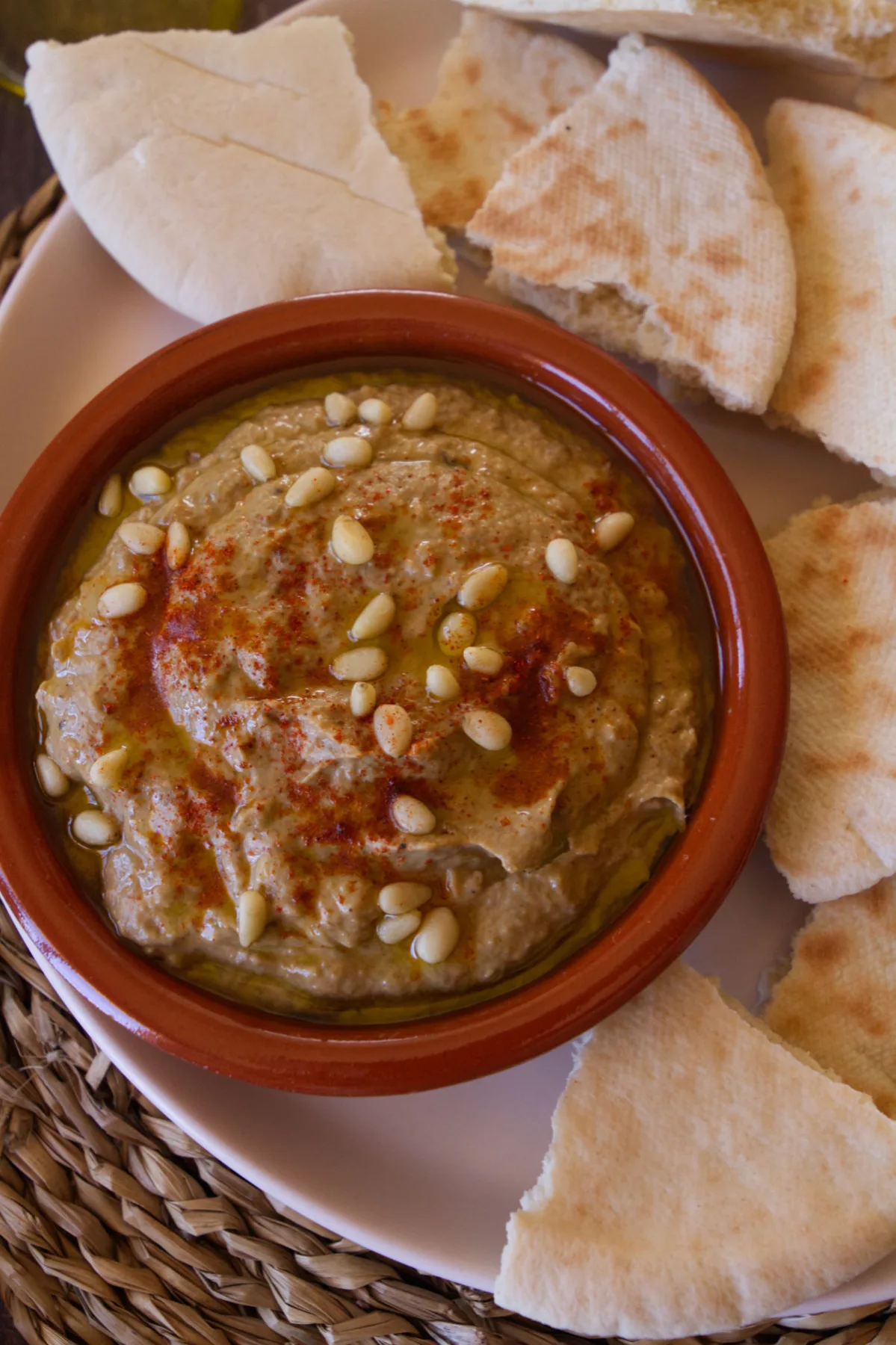
Recipe Cooking Tips
- To achieve a smokier flavor, you can grill the eggplants on an open flame rather than roasting them in the oven.
- If you’re roasting your eggplant in the oven, score them with a sharp knife (in a criss-cross pattern) and lightly glaze with olive oil, and season with smoked paprika and some salt.
- Experiment with the ratio of tahini and lemon juice to achieve your preferred balance of flavors and creaminess.
- For a smoother texture, use a food processor instead of a blender. Pulse for around 2 minutes for a smooth creamy texture.
- Flavors of the dip will meld when refrigerating for a few hours before serving.
Is Baba Ganoush Healthy?
Baba ganoush is made from natural unprocessed nutrient-rich ingredients and spices, which all make it healthy.
The ingredients offer more than a few benefits:
- Rich in Antioxidants: Eggplant is rich in anthocyanins, a type of antioxidant that gives certain fruits and vegetables their deep purple color. These antioxidants can help protect cells from oxidative stress and can contribute to overall health. They have been studied for their potential role in preventing certain types of cancers.
- Heart-Healthy Fats: Tahini, a key ingredient in Baba ganoush, is made from sesame seeds and is a source of heart-healthy monounsaturated and polyunsaturated fats. These fats can help lower bad cholesterol levels and reduce the risk of heart disease.
- Good Source of Fiber: Both eggplant and tahini are good sources of dietary fiber. Fiber is essential for digestive health, as it promotes regular bowel movements and helps maintain a healthy gut.
- Vitamins and Minerals: Baba ganoush contains vitamins and minerals like vitamin E, vitamin B6, folate, potassium, and magnesium. These nutrients play various roles in supporting immune function, nerve function, and overall well-being.
- Plant-Based Protein: Sesame seeds used in tahini are a source of plant-based protein. While the protein content in tahini isn’t super high, it can contribute to your daily protein intake, especially in combination with other protein sources.
- Weight Management: Baba ganoush is relatively low in calories and contains healthy fats, fiber, and protein. This combination can keep you feeling fuller longer and control hunger, potentially keeping you away from sugary snacks.
- Diabetes Management: The fiber content in Baba ganoush can help stabilize blood sugar levels by slowing down the absorption of sugars from the digestive tract.
Enjoy baba ganoush as part of a balanced diet by pairing it with whole grains, fresh vegetables, and lean protein sources for a well-rounded meal.
If you’re on a low-fat diet, make sure you watch how much you eat as it does contain saturated fats from the tahini and olive oil.
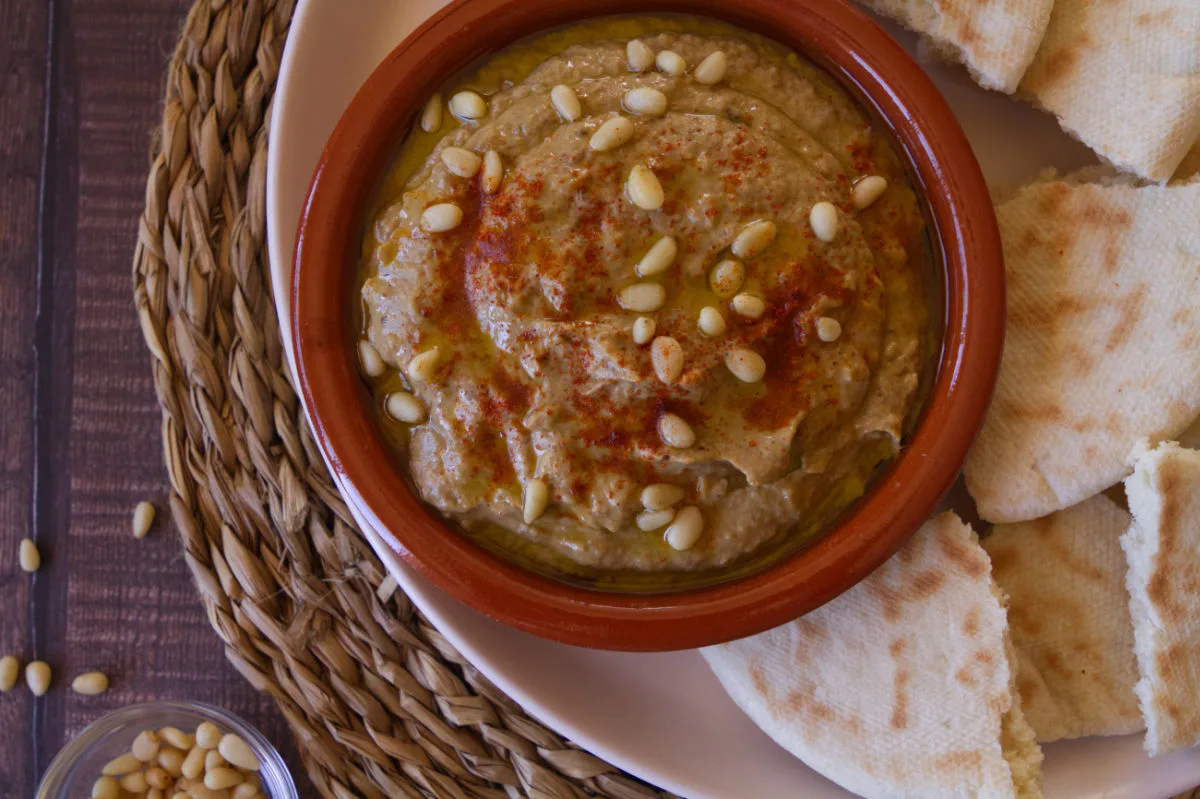
FAQs About Baba Ganoush
Can I make baba ganoush without tahini?
Yes, you can. While tahini is a traditional ingredient that contributes to the dip’s character, you can omit tahini and use a substitute such as nut butter, Greek yogurt, or sesame oil.
How do I char the eggplant for that smoky flavor?
You have two options: 1) Char the eggplant by placing it directly over an open flame (gas stovetop) until the skin is blistered and charred. 2) Sprinkle the eggplant pieces with smoked paprika and roast them in the oven until they’re tender.
Do I need to cook the eggplant on an open flame to make baba ganoush?
No, not at all. Using an open flame to cook the eggplants is a traditional cooking method and adds a level of smokiness to the eggplant. You can achieve comparable results when roasting eggplant in the oven and using smoked paprika for seasoning.
What if my baba ganoush is too thick?
If your Baba ganoush turns out too thick, you can add a bit of water, lemon juice, or olive oil to thin it out to your preferred consistency.
Is baba ganoush a healthy option?
Absolutely! Baba ganoush is low in calories and rich in vitamins and antioxidants, especially from the eggplant. It does contain fat from the tahini and olive oil though (good fats), so enjoy it in moderation.
How do I store leftover baba ganoush?
Store it in an airtight container in the refrigerator for up to 3-4 days. Give it a stir before serving leftovers.
Can I customize the spices in baba ganoush?
Certainly! Feel free to experiment with additional spices like ground coriander, sumac, or a sprinkle of lightly toasted sesame seeds.
Nutrition Facts
| Serving size: 80g | |
| Servings: 6 | |
| Amount per serving | |
| Calories | 193 |
| % Daily Value* | |
| Total Fat 15.8g | 20% |
| Saturated Fat 2.3g | 12% |
| Cholesterol 0mg | 0% |
| Sodium 417mg | 18% |
| Total Carbohydrate 11.4g | 4% |
| Dietary Fiber 5.6g | 20% |
| Total Sugars 3.6g | |
| Protein 4.7g | |
| Vitamin D 0mcg | 0% |
| Calcium 101mg | 8% |
| Iron 2mg | 12% |
| Potassium 353mg | 8% |
| *The % Daily Value (DV) tells you how much a nutrient in a food serving contributes to a daily diet. 2,000 calorie a day is used for general nutrition advice. | |
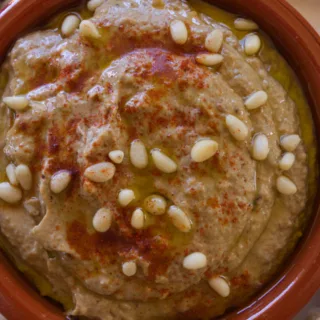
Baba Ganoush: Exploring the Smoky Eggplant Dip from Lebanon
Equipment
- Chopping board
- Sharp knife
- Food processor or blender (food processor makes it creamier)
- Lemon squeezer (optional)
Ingredients
- 2 large eggplants approx weight 10oz./300g each
- ½ cup tahini
- 8 tablespoons lemon juice approx 2 lemons
- 4 garlic cloves whole, no skin
- 1 teaspoon salt
- 1/2 teaspoon ground cumin
- ½ teaspoon smoked paprika
- Toasted pine nuts for garnish
- Extra virgin olive oil for serving
- Pita bread for serving
Instructions
- Preheat oven to 400°F/200°C.
- Cut eggplant in half then scour the flesh sides in a criss-cross pattern with a sharp knife.2 large eggplants
- Glaze the eggplant halves with some olive oil then season with smoked paprika and salt.½ teaspoon smoked paprika, Extra virgin olive oil, 1 teaspoon salt
- Roast for 45 minutes or until eggplant halves are soft in the center. For an extra smoky flavor, raise the eggplants to the top oven shelf and roast for an additional 5 minutes. This will char the eggplants.
- Remove eggplant from the oven and allow to cool slightly before scooping out the fleshy center. Discard the skin.
- Place the flesh of the eggplant in a food processor. Add the lemon juice, tahini, garlic cloves, remaining spices, and salt. Pulse a few times until the ingredients are incorporated. For a smooth consistency, blend continuously for 1-2 minutes or until you have the desired consistency.½ cup tahini, 8 tablespoons lemon juice, 4 garlic cloves, 1/2 teaspoon ground cumin, Toasted pine nuts, Pita bread




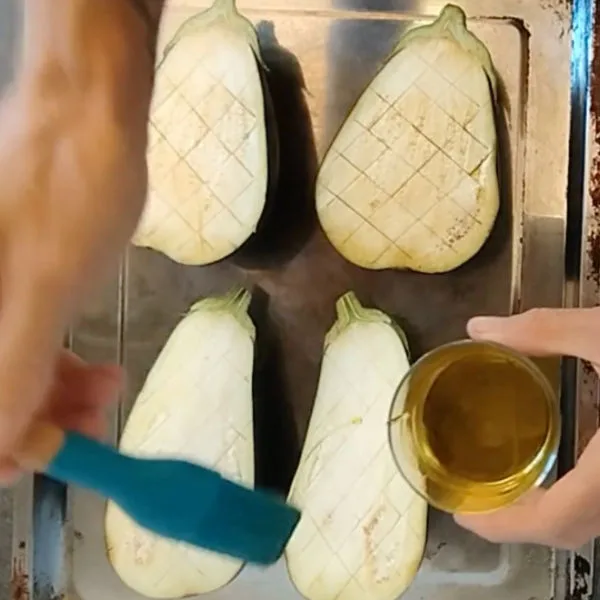
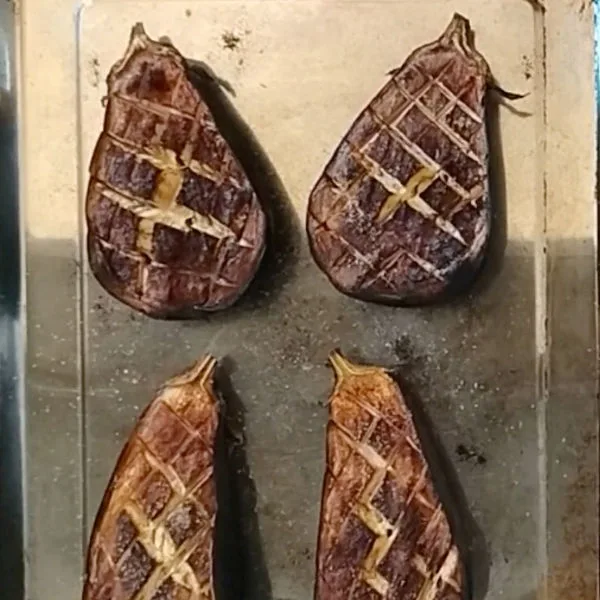

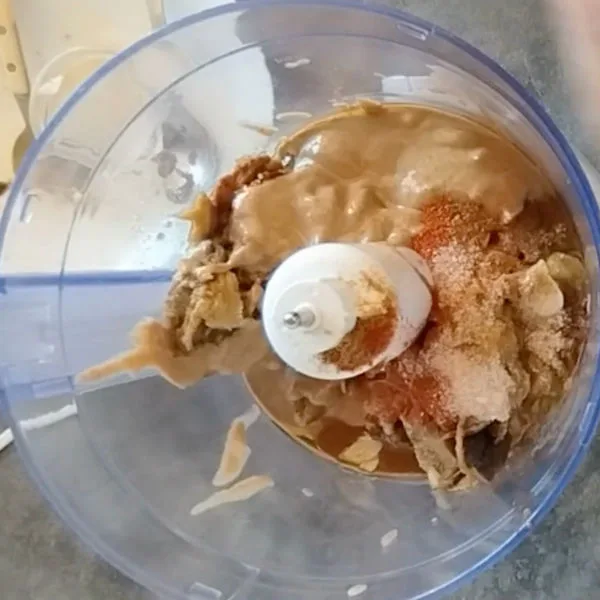
Leave a Reply